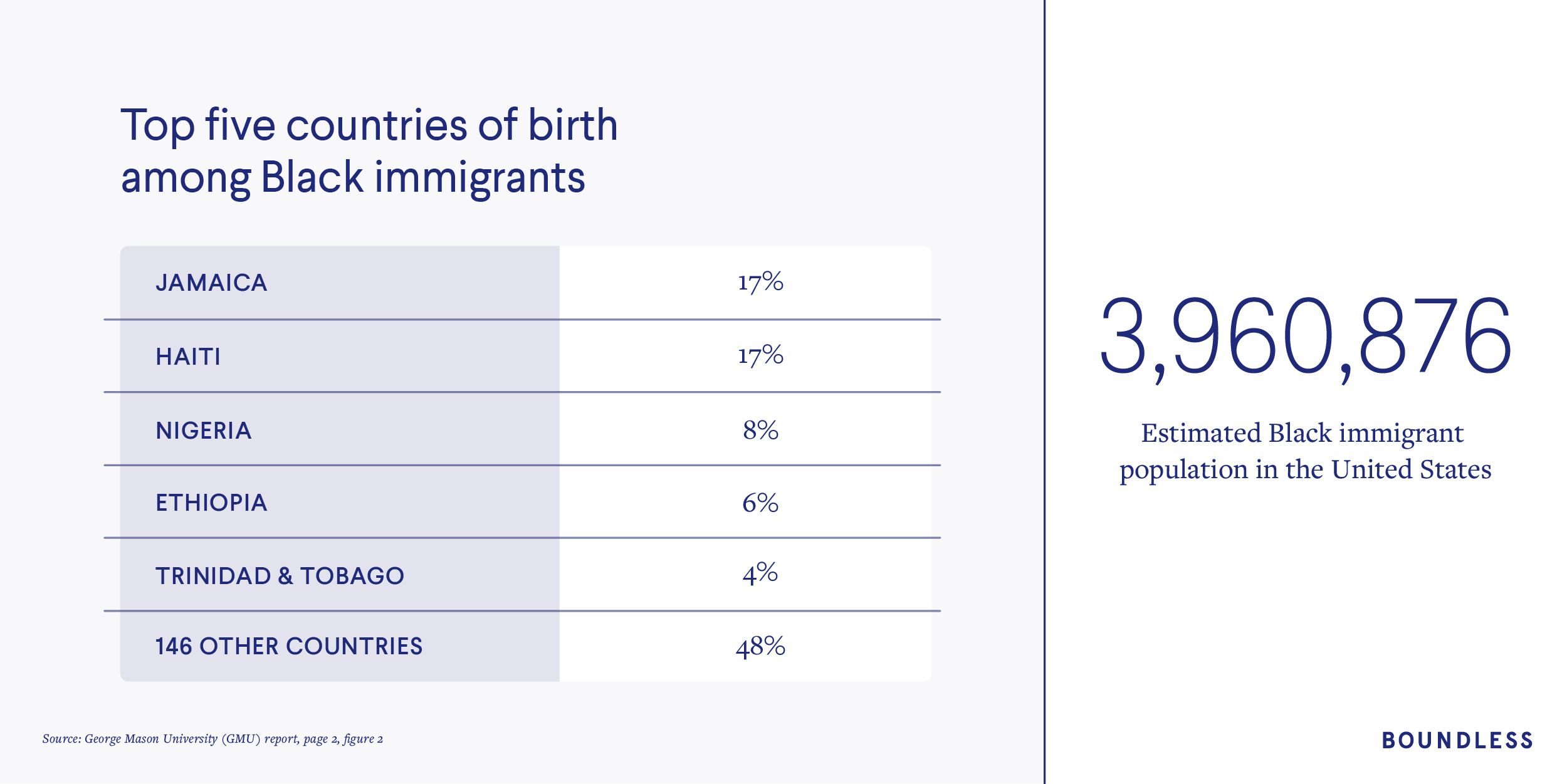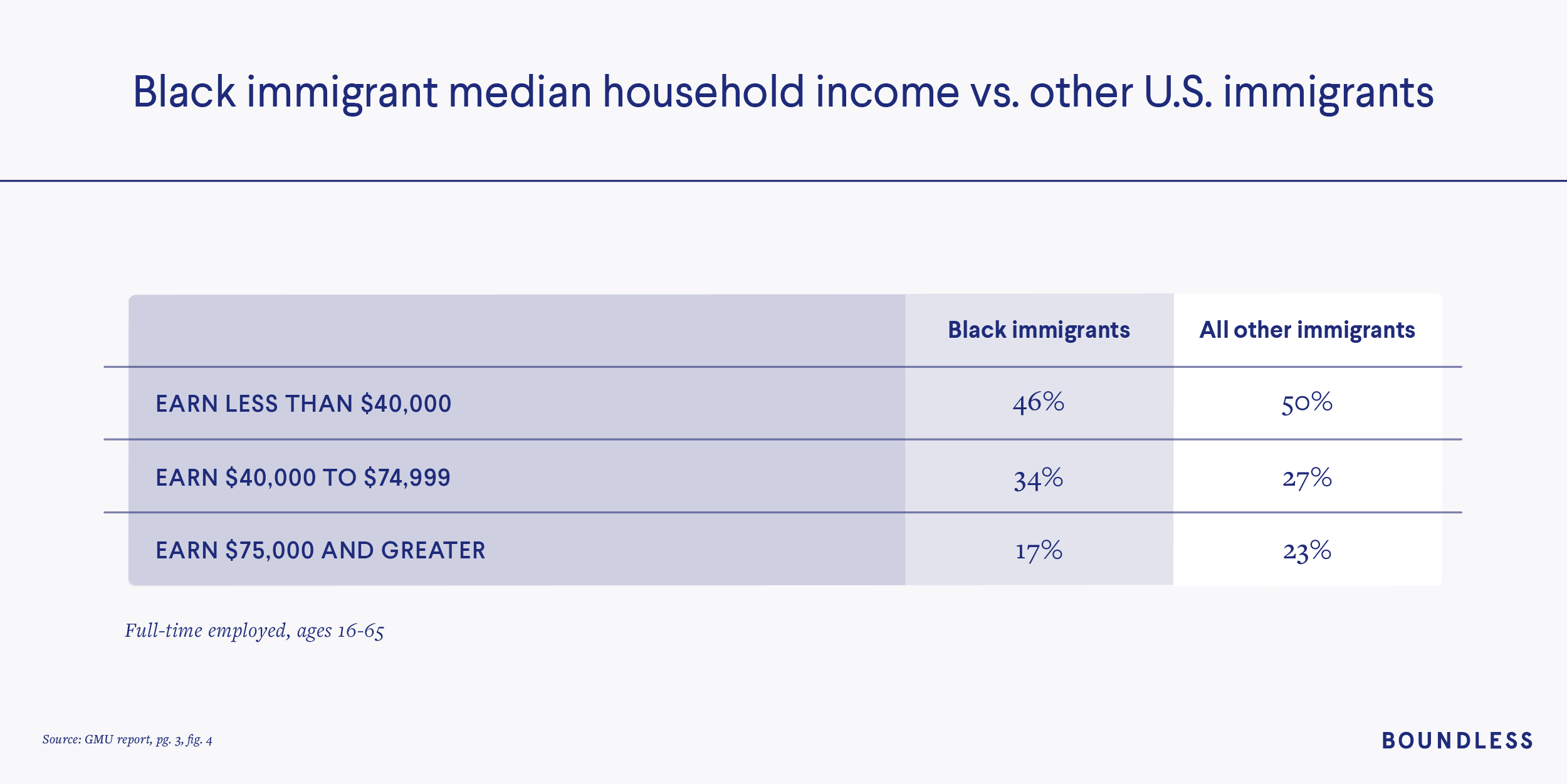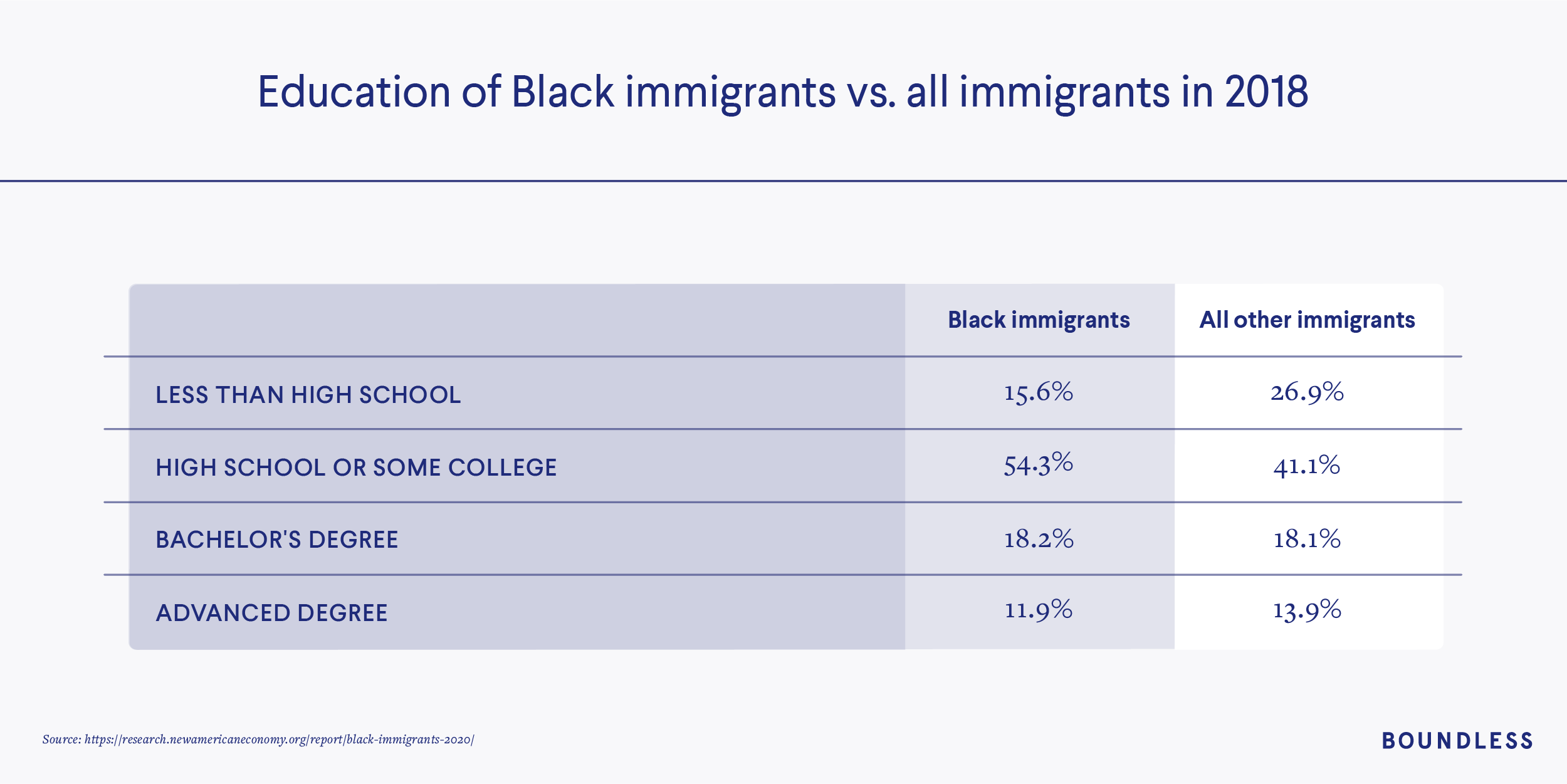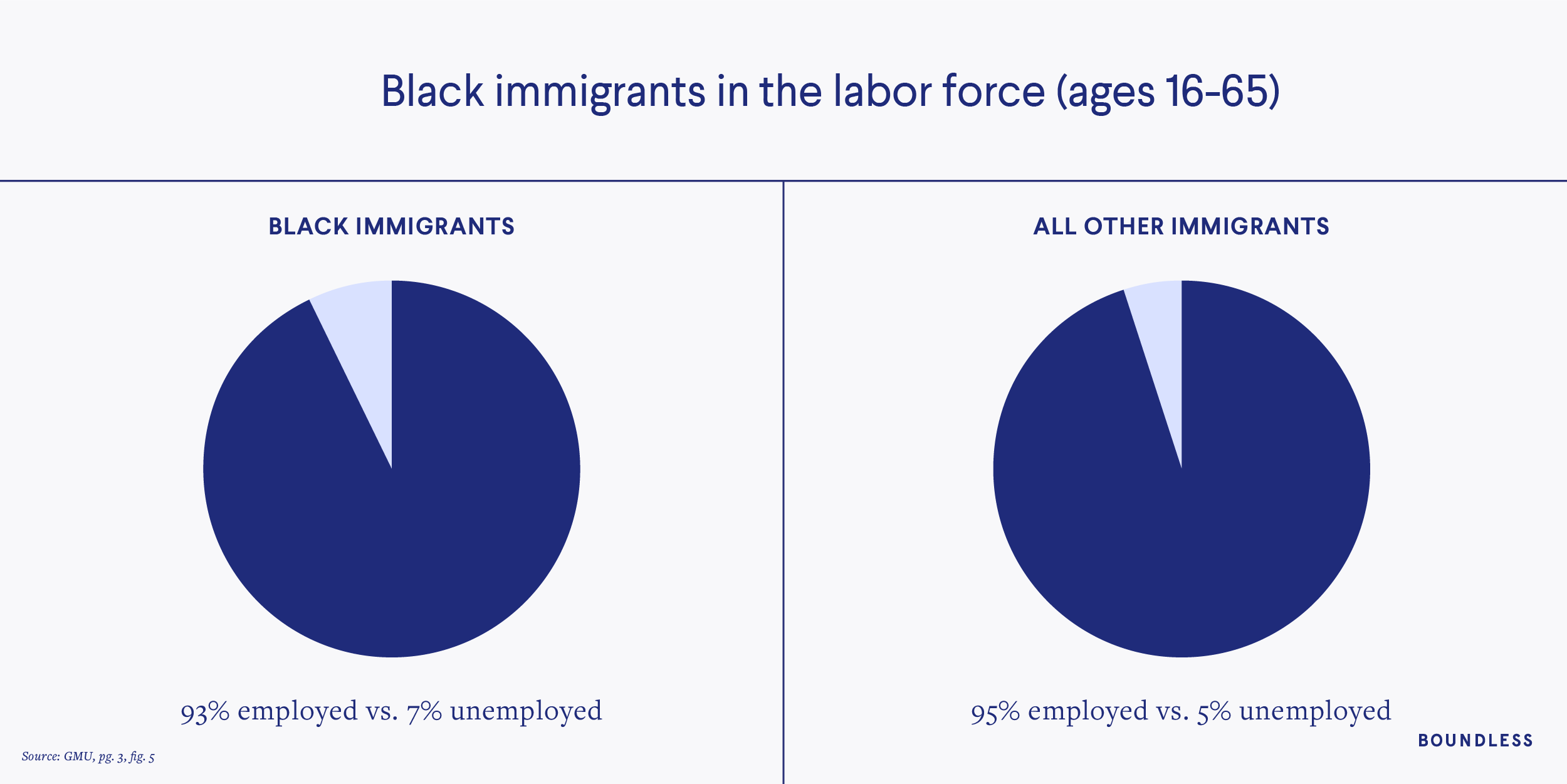RapidVisa report uses public data to examine the state of Black immigrants in the U.S.
Black Immigrants Are Part of the U.S. Immigrant Experience
The Black immigrant experience in the United States is shaped not only by where people come from and what they experience when they arrive, but also the deep-rooted history of Black individuals in the United States. The transatlantic slave trade of the 16th century brought the first enslaved Blacks to the United States. Over time, descendants of those enslaved Africans have migrated to the United States for reasons ranging from asylum to family reunification. In the past two decades, voluntary Black migration has rapidly increased, creating a growing population of Black immigrants whose story is part of the American story: people who work, pursue higher education, own homes, and contribute to the economy.
At the same time, Black immigrants face unique challenges in comparison to other immigrants, born from factors like anti-Black discrimination and racial prejudice. By understanding these challenges, we can begin to examine the realities Black immigrants face, while also highlighting the ways Black immigrants contribute to the changing face of American life.
For the purposes of this report, a Black immigrant is defined as any person who was born outside the United States to non-U.S. citizen parents and who identifies as Black or African American in the American Community Survey (ACS). Public data sources include data collected from 2013-2018.
Where Black Immigrants Migrate From
Black immigrants come from diverse regions of the world, and they tend to have lived in the United States for extended periods, according to a report by the Black Alliance for Just Immigration (BAJI). For example, Black immigrants from Jamaica, Haiti, and the Dominican Republic began moving to the United States in the 1960s.
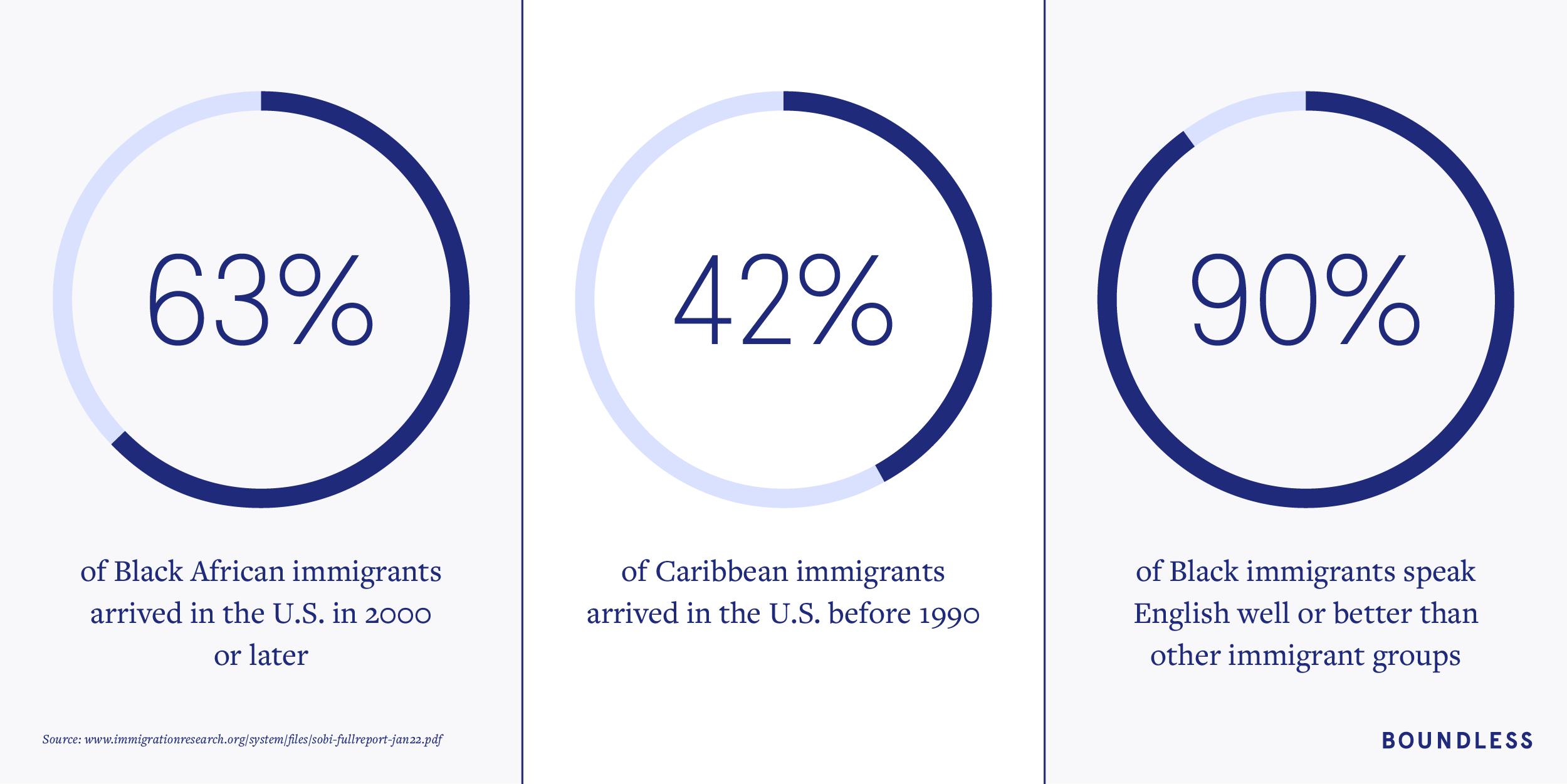
Because many Black immigrants come from English-speaking countries, such as former British colonies like Jamaica and Nigeria, they report higher rates of English proficiency in comparison to other immigrant groups: 60% of Hispanic immigrants and 81% of Asian immigrants speak English well or better than other immigrants. In contrast, 90% of Black immigrants speak English well or better than other immigrant groups.
Where Black Immigrants Call Home
Black immigrants tend to live in highly concentrated regions of the country. With 863,901 Black immigrants in 2018, New York is the top state of residence — but trends show that the Black immigrant population in other states is significantly growing.
From 2010 to 2018, Florida saw close to a 15% growth rate, and Texas hit nearly 81%, according to research by the New American Economy Research Fund (NEA). In comparison, New York only saw a 2.9% growth rate.
While New York, Florida and Texas are three of the top states in terms of the number of Black immigrants, the following states have the highest percentage of immigrant population that is Black:
- North Dakota
- Maryland
- Minnesota
- South Dakota
- District of Columbia
Black Immigrants’ Socioeconomic Status
From employment to income, Black immigrants are significant contributors to the U.S. economy.
Most Black immigrants are adults, with a median age of 42 years old. This is similar to the median age for all U.S. immigrants: 43 years old. Black immigrants from Africa skew slightly younger at 37 years old.
In comparison to other immigrants, Black immigrants are less likely to own a home. According to a 2013 report by Pew Research Center, there isn’t much of a difference in homeownership rates between U.S.-born and foreign-born Blacks. Approximately 42% of U.S.-born Blacks are homeowners, in comparison to 40% of Black immigrants.
Meanwhile, fewer Black immigrants (48%) are married in comparison to all U.S. immigrants (60%). Living arrangements also differ between immigrant groups. A larger percentage (83%) of Black immigrants live in a family household, which the United States Census Bureau defines as a household that includes both a family and unrelated people.
Income
Black immigrants have lower household incomes than that of all U.S. immigrants. The median annual household income for Black immigrants in 2013 was $43,800, in comparison to $48,000 for all U.S. immigrants. Additionally, Black immigrants are less likely to earn $75,000 or above compared to other immigrants.
The poverty rate among Black immigrants is higher than it is among all Americans, but similar to that for all U.S. immigrants. Pew reports that 20% of Black immigrants live below the poverty line, which falls between 13% of Asian immigrants and 24% of Hispanic immigrants. In comparison, 16% of overall Americans live below the poverty line.
Education
Black immigrants attain their education on par with the general U.S. population:
- 54% of all Black immigrants have a high school degree or some college, in comparison to 59% of the U.S.-born population.
- 27% of Black immigrants have obtained degrees through higher education, which is three points lower than the U.S. population as a whole.
- 34% of African immigrants have at least a bachelor’s degree, in contrast to 30% of Asian immigrants and 11% of Hispanic immigrants.
Notably, African immigrants are more likely to hold an advanced degree than the U.S.-born population: In 2018, nearly 16% of African immigrants reported having a master’s, professional, or doctorate degree, in comparison to 12% of the U.S.-born population.
The Diversity Immigrant Visa Program (also known as the green card lottery) is one contributing factor to the rates of Black immigrants with higher education. Applicants must have at least a high school degree or two years of qualifying work experience. Of the 55,000 total visas offered through the program, 5,000 go to beneficiaries of the Nicaraguan Adjustment and Central American Relief Act (NACARA), according to the BAJI. From 2005-2014, Africa received nearly 46% of all diversity visas, as opposed to 0.02% of diversity visas issued to Caribbean immigrants.
Employment Status
In the labor force, Black immigrants have a slightly lower employment rate than all other U.S. immigrants: 93% vs. 95%, respectively.
Within this group, a person’s employment may be influenced by the circumstances in their home country. In a study of the integration outcomes of African immigrants in the United States, researchers found that labor force participation rates are higher than that of the foreign-born population and general U.S. population. “Participation rate” is defined as the number of employed and unemployed-but-looking individuals aged 16 years and older.
The study found that African immigrants reported a 73% percentage rate, which is 10 points greater than that of native-born Americans. One potential contributing factor: the study’s author, Abel Chikanda, said that refugees have six months to become self-sufficient after arriving in the United States.
Overall, a significant percentage of Black immigrants work in healthcare: nearly 28%. Of that group, approximately 10% work as nursing assistants, 6% as personal care aides, and 4% as registered nurses, according to the NEA.
How Have Black Immigration Patterns Changed Over Time?
The history of Black immigrants in the United States begins with the transatlantic slave trade, which brought 388,000 enslaved Africans to North America beginning in the 16th century. Although Black immigrants have long been a part of the American landscape, their share of the population has rapidly increased within the past two decades.
According to ACS data, there were 816,000 Black immigrants in the United States in 1980. By 2000, that number had risen to 2.4 million. Black immigrants now account for nearly 10% of the nation’s Black population at 4.2 million people. Within this group, the number of African immigrants has seen a significant increase: There were approximately 574,000 African immigrants in the United States in 2000, and 1.5 million in 2014.
The Census Bureau projects that 16.5% of the nation’s Black population will be foreign-born. This projection is nearly double the population of foreign-born Blacks in 2015 (8.9%).
Discrimination Against Black Immigrants
It’s an unfortunate truth that Black immigrants are also subject to the anti-Black discrimination and racial prejudice that face Black American citizens. Black immigrants face distinct challenges by virtue of their immigration status.
According to the BAJI, Black immigrants are more likely to be detained for criminal convictions than immigrant convictions in comparison to the overall immigrant population. They are also more likely to be returned to their home country and prevented from returning than immigrants of other races or ethnicities. The Center for Migration Studies found that 76% of Black immigrants are deported on criminal grounds, as opposed to 45% of all immigrants.
Discrimination includes the classroom. In a 2015 report about the perceptions of Black immigrant collegians, the authors found that English language learners in the study were considered academically inferior and felt their contributions were dismissed in the classroom—even if they were more academically prepared than their American classmates.
In the workplace, African and Caribbean immigrants experience more occupational segregation than whites, according to a 2019 study of Black immigrants’ occupational segregation in the United States. “Occupational segregation” refers to systemic concentrations of workers in particular jobs. The researchers note that both African and Caribbean immigrants feel they have no long-term future in their roles “because employers have negative perceptions of their skills.” This sentiment is reflected in the levels of professional discrimination faced by Black immigrants and Black citizens alike: during the hiring process, Black applicants are less preferred than white applicants, and Blacks are less likely to be promoted into managerial or supervisory positions than whites.
Taken as a whole, Black immigrants are a small, but rapidly growing portion of the immigrant population with unique attributes, backgrounds, and challenges. They are more likely to speak English than U.S. immigrants overall, they have higher labor force participation rates than U.S.-born whites, and they are among the most highly-educated immigrant groups. Black immigrants have impacted the landscape of this country for centuries; moving forward, they play a crucial role in defining what it means to be not just an immigrant in the United States, but an American.
About the Data
The following public sources were used:
- George Mason University Institute for Immigration Research, “Immigrants in the United States: A Comparison of Black Immigrants and All Other Immigrants”
- “The State of Black Immigrants,” The Black Alliance for Just Immigration, NYU School of Law Immigrant Rights Clinic
- “Being Black and Immigrant in America,” Center for Migration Studies
- “Power of the Purse: The Contributions of Black Immigrants in the United States,” New American Economy Research Fund
- “Key Facts About Black Immigrants in the U.S.,” Pew Research Center
- “What Does It Mean to Be a Black Immigrant in the United States?” The Immigrant Learning Center
- Abel Chikanda & Julie Susanne Morris (2021) Assessing the integration outcomes of African immigrants in the United States, African Geographical Review, 40:1, 1-18, DOI: 10.1080/19376812.2020.1744455

